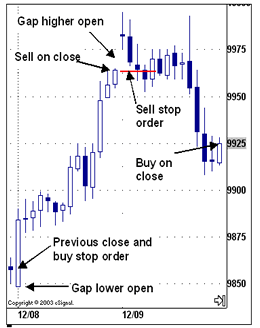
Capitalizing on a Market 'Mistake'
By: Larry Williams
Sometimes a market makes a
move in one direction, decides it has made a mistake and then reverses
course in the other direction. One such pattern is what I call an 'oops'
signal.

OOPS signals are most effective when they occur at the beginning of a
regular daily trading session in a liquid market. I do not take all such
opening signals. I filter them with fundamental and technical indicators,
as I teach at my seminars.
The chart shows several examples of OOPS signals in the mini-sized Dow
futures market on Dec. 8-9, 2003. (Note: Although the mini-sized Dow trades
electronically almost around the clock, this 30-minute chart is for the
trading hours from 8:30 a.m. to 3 p.m., Central time, to coincide with
trading on the New York Stock Exchange, the 'regular' session underlying
the Dow index.)
Dow futures closed at 9858 on Dec. 7 and then opened on Dec. 8 at 9848,
a gap lower opening. Then enough buying comes into the market on Dec.
8 to turn the initial price direction around, and momentum takes prices
back above the previous close and sharply higher. A buy stop placed at
the previous close (or the previous low or high or some other point of
your choice) after the open would get you onboard the rally.
In this case, if you bought at, say, 9860 and sold on the close in the
vicinity of 9960, you would have had a profit of 100 points or $500 per
contract.
The chart shows a similar OOPS sell signal on Dec. 9, but this trade would
have been more of a challenge to manage and your profit would not have
been so large. Following the Dec. 8 close at 9963, the market then left
a gap when it opened higher at 9980 on Dec. 9. A sell stop placed around
9960 would have gotten you short on the price setback about an hour after
the open. Whether you stayed around for the ride down late in the session
depended on where you placed your protective buy stop. Assuming you weren't
stopped out, you could have exited on the close around 9925 for a 35-point
gain ($155) per contract.
Opening gaps may be caused by a news event, an economic report or some
other development that serves to surprise traders. What happens to the
gap after that depends on the collective opinions of traders as they chase
the market. If traders decide they have over-reacted to whatever caused
the gap, they may reverse their positions to get back in line with market
thinking.
Of course, like most things in trading, not every OOPS signal turns into
a profitable trade. Sometimes a gap may become a breakaway gap that begins
a powerful new move. You don't want to get in the way of that so you should
keep your buy or sell stop somewhere in the previous day's range to capture
a reversal and not guess where a turnaround may begin.
The important thing about the OOPS signal is how it reflects market psychology
and helps you capitalize on a fake-out move. Traders who think they may
have made a mistake can start a stampede that feeds on itself and extends
a move higher or lower than it might have gone without the gap.
Futures trading involves high-risk with the potential for substantial
losses